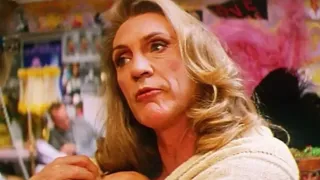September 27, 2015
Sweeney Todd: The Demon Barber of Fleet Street
Philip Campbell READ TIME: 4 MIN.
If you are of a certain age and a musical theater fan - well, alright, a show or an opera queen - check all boxes that apply and attend the tale of "Sweeney Todd: The Demon Barber of Fleet Street," the second production in the San Francisco Opera's fledgling fall season. Stephen Sondheim's masterpiece has finally hit the boards of the War Memorial Opera House, and despite some curious technical drawbacks, it remains a monster hit 36 years after the Broadway premiere.
There is nothing in director Lee Blakely's staging from Theatre du Chatelet (Paris, 2011), repeated at Houston Grand Opera last spring, that will much surprise connoisseurs of the legendary entertainment. The size of the production and the casting of classically trained voices in lead roles demonstrate instead the enduring worth of Sondheim's score and the strength of Hugh Wheeler's tightly constructed book. It should also silence critics who think Sweeney can't support such grand treatment.
There have been many interpretations, done in many sizes over the years. From Hal Prince's original Victorian-style extravaganza to Off-Broadway's 1989 chamber staging (Teeny Todd) to minimalist multi-tasking director John Doyle's surprisingly effective deployment of singers doubling as orchestra, and numerous symphony concerts, including a magnificent San Francisco Symphony rendition in 2001. Most all have proved Sondheim's material is virtually indestructible. Heck, a Bunraku Puppet version would probably work.
First and foremost, there must be an appreciation of the exquisite sophistication of the lyrics. If you want to stage Sweeney as opera or operetta, singspiel, vaudeville or big, brash Broadway show, it's all good, as long as we get the words. Surprisingly, the SFO production sometimes comes perilously close to the edge.
Amplification and sound design are not new to the Opera House. Actors and singers from the popular stage must project alongside voices trained for big auditoriums, and some electronic boosting is required. All principals for the current production have been fitted with body microphones, "primarily to assist with clarity of dialogue." After the subtle microphoning done for the recent Show Boat, the sound design in Sweeney proves more intermittently effective. Voices are sometimes disconcertingly close or disembodied, and hard to match with the speakers' positions. Projection of the dialogue is accomplished, but dramatic nuance (or humor) is occasionally lost. It doesn't sink the show, but it is distracting and should be fixed.
If you want to concentrate on the wit of the wordplay easily, the two most important characters in Blakely's staging are, thankfully, delivering performances of outsized excellence utilizing personal acoustical power.
American baritone Brian Mulligan may seem a little one-note in his angrily seething representation of the revenge-crazed title character, but his ticking time-bomb interior is superbly clarified by his rich and communicative voice. His range is remarkable, especially fine at the bottom, and his somewhat restrained depiction of Sweeney's unbearable angst builds to a substantial portrait of a man possessed.
Also relying on voice (oh mama, what a voice!), but also some impeccable comic timing, American mezzo-soprano Stephanie Blythe boldly tears down the house as the barber's partner-in-crime Mrs. Lovett. Darker and maybe a little meaner than others before her in the role of London's cannibalistic pie-maker, Blythe is still a welcome comic foil to Mulligan. Her utter amorality is perversely funny and even a little sympathetic.
Making his SFO debut as the ardent young sailor Anthony, baritone Elliot Madore displays an unusual tone that gives his character depth. He sings the gorgeous song "Johanna" with an impact that is also dramatically convincing. He is amplified in dialogue, but I wonder (as with Mulligan and Blythe) if it is really necessary.
Soprano Heidi Stober is less successful as the imperiled and humorously ditzy object of his affection. Her bright tone is appropriate, and her physical presence is appealing. Without the supertitles (and our familiarity with the lyrics), though, much of her performance is hard to understand.
Bass-baritone Wayne Tigges (well-remembered from the SFO world premiere of Dolores Claiborne) adds the role of the wicked Judge Turpin to his repertoire of operatic baddies with characterful assurance.
A little bland in the acting department but thoroughly believable in their vocalism, tenor Al Glueckert (former SFO Adler Fellow) and soprano Elizabeth Futral (looking a bit too fresh) help the plot speed along as they portray the slimy Beadle Bamford and the mad Beggar Woman. We won't spoil the crazy lady's big "reveal" if you haven't seen the show, but it's a knockout.
Tenor Matthew Grills, a winner of the 2012 Metropolitan Opera National Auditions, sings the role of Tobias Ragg and his part in the duet "Nothing's Gonna Harm You" with heart-stopping expressiveness. His deft combination of operatic and Broadway lyricism earned him one of the heartiest audience ovations of the night.
Ian Robertson's SFO Chorus, assuming many characters with customary skill, raises genuine goosebumps as the Ensemble of Londoners, stevedores, industrialists and policemen.
The production design of Tanya McCallin (SFO debut) is mammoth and claustrophobic, not unlike the famous original Broadway design by Eugene Lee, but with dark-hued costuming and monochromatic lighting by Rick Fisher, the stage picture is even more menacing.
Jonathan Tunick's marvelous orchestrations (as recognizable in so many Sondheim scores as the legendary collaboration of Robert Russell Bennett and Richard Rodgers) secure a rightful place for "Sweeney Todd" in the canon of great popular American operas.
The orchestra, even with reduced strings (25), under conductor Patrick Summers (James Lowe will make his SFO debut in the closing performance on Sept. 29) helps convey a symphonic sweep, and the participation of organist Simon Berry (SFO debut) adds to the sense of restless musical foreboding.
Sondheim has never pronounced a personal favorite among his works, but judging from the recent audience response, his enthralling tale of Sweeney Todd will likely become his greatest legacy.
In repertory through Tues., Sept. 29






